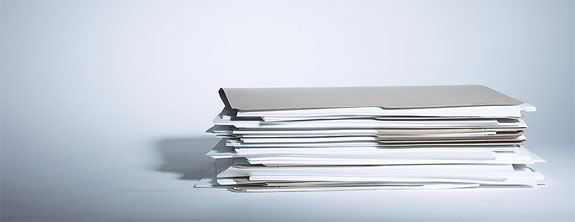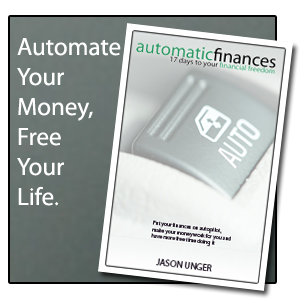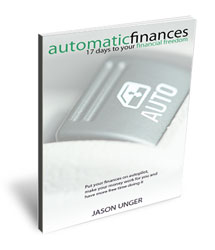
As I mentioned yesterday, I’m giving away my ebook, Automatic Finances: 17 Days to Your Financial Freedom! Over the next two-and-a-half weeks, I’ll be posting a chapter a day from the book for your consumption.
If you like what you’ve read, you can get yourself a PDF version of the ebook using the “buy now” link to share with your friends. If you don’t, you don’t have to buy it. (The ebook does have a 100% satisfaction guarantee, so I’d refund your money any way if you didn’t like it.)
I won’t use this same message every day, but you get the gist.
So, here’s Day 1: Organize Your Finances.
******************************
For many people, especially those who have been working, spending and saving for a long time, it’s easy to get lost in the clutter of old bank receipts, 401(k) statements and credit card bills. You’ve probably got a stack – if not 10 stacks! – of them lying around, shoved in a shoebox or filed away in a drawer somewhere.
It’s time to get them out.
Organizing your existing accounts and finances can be a laborious task, but it’s crucial in order to establish your current situation. The goal for Day 1 is to find where your money currently is, close out any accounts you aren’t using and start banking online.
Gather all the information on any financial account you have, including:
- checking
- savings
- credit cards
- mortgage
- loans (car, school, personal)
- 401(k)/403b
- IRA/Roth IRA
- any other investments or debts
If you’ve been receiving paper statements from your bank or credit union, find at least one copy for each account. If you manage the account online, make sure you have your identifying information, like account number and username/password.
Don’t forget that you probably have multiple accounts in each group – 2 or 3 credit cards, the 401(k) from your last job, or a checking account you never closed. Make sure you get them all.
Organize it!
Once you have the information for all your accounts, it’s time to get organized.
On a sheet of paper (or, in a text document on your computer), write down:
- the name and type of each account (ex. Bank of America, checking)
- the current balance (use a negative sign if it is a debt)
- how often it is used (daily, monthly, never)
This is your current balance sheet. While it’s a little low-tech right now, you’ll be blown away by it in just a few days.
Keep your balance sheet in a safe place. You’ll only need it for a couple more days, but like with any financial information, you don’t want the wrong eyes seeing it.
Close Down Inactive Accounts
Now it’s time to close any inactive accounts.
If you have a department store credit card from 1995 with no balance, close it. If you have a checking account with little to no cash in it, withdraw the money and close the account. Same thing with investment accounts; if you aren’t using it, get rid of it.
By closing down your inactive accounts, you’ll trim the fat on your financial picture and keep only the essential accounts open.
Your Master Checking Account
The Automatic Finances system requires one master checking account, where money can be deposited, bills can be paid from, and savings can be transferred out of.
One of your accounts needs to be low-fee (preferably no-fee) with no limits on the number of transactions.
If you don’t have this account already, you need to set one up.
Enroll in Online Banking
If you’re not already banking online, today will be a big step for you.
People have been banking online for years (the first systems were established in the 1980s, with the first bank to offer it to its members in the ’90s), so you can feel comfortable doing it, too.
Using your balance sheet of accounts, determine which you already manage online. You should already have username and passwords for these accounts.
For the accounts you aren’t currently managing online, it’s time to start.
Since this process will be different for you than for anyone else, you’re going to have to do a little bit of digging here.
To find out how to enroll in online banking or open a new account:
- Go to your bank’s Web site (or Google their name to find their URL)
- Find the link to “Enroll” or “Register” or something similar
- Answer any questions and input your account information
If you’re unable to enroll in their online banking program, you may have to call their toll-free 800 number to get set up. If you’re setting up your master checking account, the process is likely to take a little longer than for other accounts.
When you enroll, you’ll set up or receive a user name and password. Make sure you keep records of this!
After you set up your online banking account, do the same for:
- credit cards (if they are separate from your bank)
- loans
- 401(k) or other retirement account
(You may have to get some information from your human resources manager about accessing your work-related retirement accounts online.)
Where to Store Your Username and Passwords
Now that you have username and password information for all of your accounts, it’s important that you keep them safe.
Without question, don’t give them out to anyone. Any email you get requesting them (or other personal information, like your Social Security number) should be immediately disregarded.
When you’re on the phone discussing your accounts, be sure you know whom you are speaking to. Use common sense: never tell your personal information to someone who calls you.
If you have a tendency to forget usernames and passwords, there are a number of secure programs you can use to store them on your computer. Head to lifehacker.com and do a search for “store passwords” and you’ll find some good advice about which ones to use.
A Word on Security
When you’re banking online, you should always be aware of:
- what site you are on (make sure it’s the actual bank site)
- the security measures they use (check your browser for a site verification from companies like VeriSign)
- your computer’s vulnerability (make sure you are free of viruses, spyware and other malware)
Believe it or not, doing all of your banking online actually reduces your chance of identity theft, according to James Van Dyke, founder of Javelin Strategy & Research.
To find out more, the FDIC (Federal Deposit Insurance Corporation) provides tips for safe online banking.
You’re Already On Your Way!
Believe it or not, getting a handle on your accounts can be the biggest step toward reaching your goals.
Money has a way of overwhelming people, and being buried in statements doesn’t help. It’s almost impossible to avoid having at least 6 or 7 accounts, so by taking the time today to organize your finances and enroll in online banking, you’ve already made great progress!
Enjoy the rest of today. You’ve earned it!
TIP: While getting together the paperwork for all of these accounts might be a pain, in 16 days you’ll never get a paper statement again (and might save money doing it). Sounds great, right? Keep up the great work, and you’ll be there before you know it.



